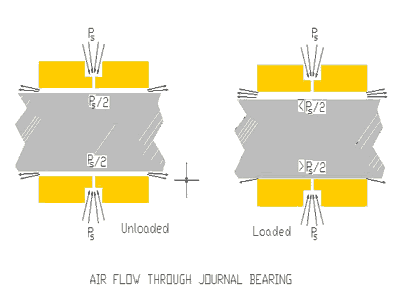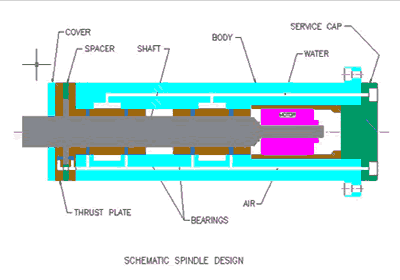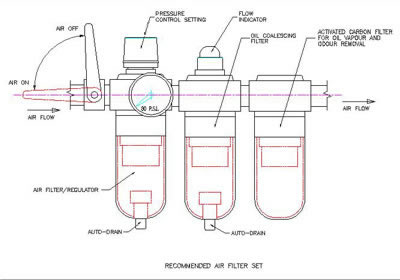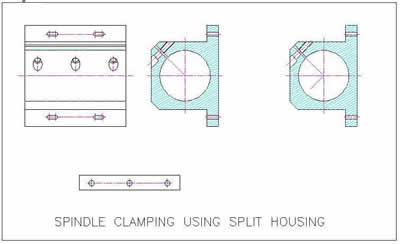How Air Bearings Work
How air bearings work
The basic principle of operation of air bearings has been established for more than fifty years. An air bearing may comprise of a sleeve separated from a plain shaft by a small gap, typically 5–50 um. High pressure air is fed through small holes in the sleeve through to the bearing gap where it flows along the gap to the end of the bearing. Orifice size is matched to the bearing size in order that under "no load" the pressure in the gap, just downstream of the orifice, is approximately half the supply pressure. When a radial load is applied, the gap on one side of the shaft closes down increasing its resistance to airflow and causing pressure to rise. On the opposite side of the shaft, the larger gap has a reduced resistance to airflow and allows pressure to fall. The pressure difference across the bearing gives it the capacity to support the applied load without incurring any metal-to-metal contact even if there is no shaft rotation.

Air bearing spindles
Loadpoint air bearing spindles employ 2 or more cylindrical journal bearings to support radial loads and an opposed pair of flat, annular thrust bearings to support axial loads. A practical design of air spindle also has an integral drive motor and means of work holding.
In a typical spindle, compressed air enters through a port on the rear face and is fed through drillings to reservoirs surrounding each journal bearing and reservoirs positioned either side of the thrust bearings. From the reservoirs, air is fed through rows of orifices into the bearing gaps. Exhaust air from the ends of the journal bearings, inner and outer edges of the thrust bearings is vented to atmosphere.
Cooling water enters the air bearing spindle through a port on the rear face. From here it is typically ducted along the spindle where it flows through a reservoir surrounding the front bearing. The cooling water is then fed back along the spindle where it passes through a reservoir surrounding the rear journal bearing before exiting through a port on the spindle’s rear face.

Advantages
Compared to other types of spindle, air spindles have a number of performance advantages:-
High Rotational Accuracy – Bearing air films average any surface features to a low level enabling error motions of less than 0.05 um TIR to be achieved.
Low Vibration – All air spindles are balanced to better than 0.001 gm cm.
High Dimensional Stability – Low bearing friction and water cooling enables negligible thermal growth to be achieved.
High Speeds – Again low bearing friction and the use of water cooling allow bearings to operate at extremely high surface speeds.
High Stiffness - The small clearances inherent to air bearings enables them to be designed with high static stiffness. Air bearings also enable large shaft diameters to be used which enhances the stiffness of spindle assemblies.
Increased Bearing Life – The absence of metal-metal contact ensures an unlimited bearing life provided the air supply is maintained clean and free from oil and water.
Improved Surface Finish – Due to the inherently high accuracy of rotation of air bearings and low vibration, air spindles use in machining applications can produce surfaces with mirror finishes.
Cleanliness – Not requiring any liquid lubricants air spindles are suitable for use in clean rooms.
Ease of Maintenance – Air spindles do not require servicing. Air supplies must however be maintained.
Air supply
 The air supply is crucial to spindle operation. A clean, dry supply of air at the spindle's specified operating pressure is essential to avoid any long term deterioration in spindle accuracy. Furthermore any loss in air flow or obvious presence of contamination may lead to catastrophic spindle failure.
The air supply is crucial to spindle operation. A clean, dry supply of air at the spindle's specified operating pressure is essential to avoid any long term deterioration in spindle accuracy. Furthermore any loss in air flow or obvious presence of contamination may lead to catastrophic spindle failure.
Quality
Air quality suitable for supplying Loadpoint air bearings is defined in terms of its levels of contamination by solid particulates, water vapour and aerosol oil content.
Contamination levels should conform to the following ISO 8573-1 specifications where concentrations apply to air at 1 Bar pressure and a temperature of 20 deg C.
Type of contamination ISO Class Specification
Solid particles 2 size Oil 1 concentration Water 5 maximum dewpoint = 7 deg C
Every Loadpoint spindle has a specified operating pressure and air consumption and the supply should be capable of meeting these requirements. Spindle supply pressure should be maintained at the specified level +/- 0.5 Bar.
Recommended Equipment
The air compressor should be an oil free type such as a rotary screw compressor and the air should be passed through a freeze dryer and expansion chamber before final filtering and regulation. A three stage filter is effective in controlling solid particles and small traces of oil and water vapour. The first stage is a 5 um prefilter and regulator with autodrain. The second stage is a 1 um coalescing filter, again with autodrain and the third stage is an activated charcoal element for removing any final traces of oil. A pressure sensitive switch should be fitted between the filter unit and air bearing spindle and used to switch off the spindle drive in the event of the air pressure falling more than 0.5 Bar below the specified operating pressure.
Care should be taken in choosing piping and fittings. They should be clean and not require jointing materials which can act as contaminants. Pipe material should be non corrosive and the pipe sized to minimise pressure drop in the spindle supply line.
Cooling the air bearing spindle
Spindles are fitted with water cooling systems for one of two reasons, either to maintain a constant, near ambient operating temperature for minimising thermal growth or in less critical applications simply to remove excessive heat that might damage the motor or reduce bearing operating clearances.
All water cooled Loadpoint spindles have specified flow rates which should be strictly adhered to. The recommended cooling system consists of a chiller recirculating clean distilled water in a closed loop arrangement. The chiller, piping and fittings should all be manufactured from non corrosive materials. Water inlet temperature to the spindle should be controlled and maintained at 18 – 21 deg C. Sensors for detecting the presence of coolant are recommended and should be used to switch off the spindle drive in the event of coolant loss.
Degradation of water quality over extended periods of operation can occur due to bacterial growth. This should be avoided as it may lead to blockage of the coolant feed pipes or porting within the spindle. The use of proprietary bacterial agents as instructed by their manufacturers provides a satisfactory solution.
Spindle clamping
The clearance in an air bearing is inherently low, typically 5 – 50 um, and must be maintained for the spindle to achieve its specified performance. Any distortion of the spindle body can be transmitted through to the bearings with the net result that they become out of round or in the case of thrust bearings out of flat. This can introduce motion errors and loss in stiffness and in extreme situations where the clearance across a diameter is lost completely the spindle will fail to rotate. Loadpoint Bearings manufacture spindles with a variety of mounting arrangements. Foot mounted and flange mounted styles of spindle are designed to minimise mounting distortions. However most spindles have cylindrical bodies and are located by clamping the outside diameter. In this case housings should be carefully designed and manufactured.
There are two basic forms of clamping that can be used. The above diagram shows the more common,utilising a split housing. Clamping takes place due to a small deflection of the housing bore. If this type of clamping is adopted, then it is recommended that a suitable piece of gauge plate be fitted accurately into the slot and clamped down prior to finishing the bore of the housing. On completion of the housing bore, the gauge plate may be removed and ground down by 25 um before replacement. A similar approach to this may be adopted if the alternative saddle clamp arrangement is employed. Care should be taken to ensure that the clamping force is spread as uniformly as possible over a relatively large area. Excessive force is entirely unnecessary and could have disastrous consequences.

